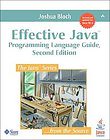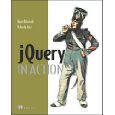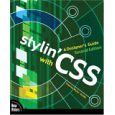 The Pragmatic Craftsman
:: Simplicity from complexity : by Stanley Kubasek ::
The Pragmatic Craftsman
:: Simplicity from complexity : by Stanley Kubasek ::
 The Pragmatic Craftsman
:: Simplicity from complexity : by Stanley Kubasek ::
The Pragmatic Craftsman
:: Simplicity from complexity : by Stanley Kubasek ::

Professional JavaScript for Web Developers (2nd ed)
by Nicholas C. Zakas
ISBN 047022780X
Date Read 4/2009
My Rating

This book has opened my eyes in the JavaScript development world. For real. I did not know object-oriented JavaScript. I did not a lot of JavaScript patterns available. Nor did I now the best practices for JavaScript. Until now. ![]()
This is the best JavaScript book out there now. I checked out almost all of them (Pro JavaScript Techniques, Javascript: Definitive Guide, and others). This book gives you all the coverage of JavaScript you need. Explained in a clear and intuitive manner. Full of examples. Great examples. I really love this book!
Excellent JavaScript coverage. Basics. Object Oriented. Events. DOM. Ajax. Best Practices. It’s all here. Plenty more, actually.
Focus on best practices. This is where this book shines. I love authors like Mr. Zakas. He tells you how you should be developing, what the best practice is.
Excellent examples. Another great aspect of this book. I learn by examples. I like to see a lot of examples. Great job by the author.
Great object-oriented coverage. There are different ways of object-oriented programming in JavaScript. Some better than others. Some more efficient than others. I have learned a great deal about JavaScript OO from the author. The author discusses numerous OO patterns and techniques.
Read this book. You will become a better JavaScript developer. I am sure about that. You will learn much, much more about the capabilities of JavaScript. I am amazed how far JavaScript has progressed.
I am more of a Java developer than a web developer. However, JavaScript is becoming used more and more. There are patterns, OO programming in JavaScript — more of a typical programming language. I predict we’ll see more and more back-end developer doing JavaScript. This book is of great help.

Effective Java (2nd)
by Joshua Bloch
ISBN 0321356683
Date Read 2/2009
My Rating

One Minute ReviewPositives* Best advanced Java book* Loaded with excellent tips* Expert voice* Broad coverage of best practices
Negatives* Some chapters too complex
General OverviewThis is the best Java book available for the advanced/experienced programmers. (For beginners, see Thinking in Java by Eckel.)
Why? Bloch shows you HOW you should be programming in Java. He shows you what to avoid. He teaches you the things that you might not be aware, or things you would only find out after you dived in to it in much detail.
NegativesI read the first edition, and this second edition is great, but some chapters have gotten a bit too complex, too difficult to understand. At least for me. I know this is really Java’s fault, as it has become a lot more complicated with version 5, but I think perhaps the author could explain it a bit better. I lost focus at times. This was the case with the chapter on Generics. Perhaps it’s just me. There are some obscure portions of generics, which are just very hard to read. (I should not blame the author for that.)
Bottom LineOverall, a great book. A must read for serious Java programmers. The tips contained in this book, there is 78 of them, are all coming from the expert. Tried and tested. And even though you might be using only a small portion, these rules of thumb are good to know, good to refer to. A very good checking point as well if you’ve been developing in Java for a few years. This book will tell you whether you’ve been going in a right direction. Or perhaps it will help you steer there.

jQuery in Action
by Bear Bibeault, Yehuda Katz
ISBN 1933988355
Date Read 1/2009
My Rating

One Minute ReviewPositives* Excellent overview of jQuery* Full of examples* Focus on effective usage* Live samples (Lab)
Negatives* In the API docs, an example would be really helpful
General OverviewI read the majority of another good book, Learning jQuery, but jQuery in Action is much better! Much more thorough, covers more material. I think this is the best book available on the subject.
This book covers a lot of material: core jquery, events, effects, utils, extending jquery, Ajax, useful plugins, OO Javascript, and more! Each topic is not covered too deeply, but enough to get a grasp. Each topic has good examples also, which made reading and comprehending it much more easier. It also makes this book a good reference book.
This book has a live lab! As you read the book, you see the examples in action! It’s really cool and useful. I think it’s a great learning tool.
I liked the authors emphasis on doing things the right way. This is especially important when learning a new framework. The examples presented in the books were not trivial but not too difficult either, nice balance.
NegativesI really liked the API documentation for the functions, in which the params are listed and explained. What would have made it even better, is if it also contained examples as part of it. It would have made this book much more reference friendly.
SummaryAll in all, this is an excellent book. The authors are detail oriented and put a lot of thought into creating this book. It shows! If you want to learn jQuery, this book is your best bet.

stylin’ with CSS
by Charles Wyke-Smith
ISBN 0321525566
Date Read 5/2008
My Rating

I looked at this book over at B&N and it got me hooked. Especially the chapter on how to do some basic page layout. I could not believe how simple it could be! The author really got me very interested and that eventually led to me buying this book. I’m glad I did. ![]()
If you’re a Java developer like me or a CSS beginner, this is a great book to get you started. It’s really easy to read. Complex concepts are explained in an easy to understand fashion. And the author follows and breeds best practices. These and many others, make this book excellent.
The book is broken in 7 chapters.
The 1st chapter explains the basics of HTML, the different standards and how the page is structured. Simple chapter, but it’s important to understand the basics.
The 2nd chapter, How CSS Works, is really a CSS 101. Basic stuff as well, but as in the first chapter, this is a fundamental knowledge.
Chapter 3 is more of a reference guide on how to style fonts and text. Some very useful info.
Chapter 4 is where the interesting stuff starts: positioning elements. An excellent overview of the box model and some good information about floating and clearing.
Chapter 5 is the best chapter in the book. It goes over several ways to create page layouts. Want to create a 2-column layout? A simple example is shown. How about a 3-column layout? 3-column liquid layout? With the techniques presented by Charles, you can create any type of a layout and you will actually understand what’s going on. Really neat stuff.
In chapter 6, focus is on styling tables, forms, and menus. The author basically presents some techniques on how to style tables for tabular data, and explains the technique on how to create CSS menus. Good chapter to dive in when you’re involved with these.
Chapter 7 summarizes the overall process of building a real site.
I learned several new techniques and tips from this book. I love how the book makes complicated things simple: this is my type of a book. Also, Charles has a good way of making sure these things come across and stay in your head. Not a simple thing to do, but he did a great job.

Core JavaServer Faces (2nd ed)
by David Geary, Cay S. Horstmann
ISBN 0131738860
Date Read 1/2008
My Rating

One Minute ReviewPositives* Lot of examples — with complete source code* Excellent writing style* Focus on helping the reader
Negatives* Some chapters deviate from others: only snippets of code and no complete examples
SummaryIf you want to learn JavaServer Faces (JSF), this is the book to learn it from! What is the best technique to learn a new technology? By examples, in my opinion. This book takes that approach to the extreme, by giving you full source for the discussed examples! This really helps to see the big picture. I really liked that style.
This book comes from the creators of JSF, so the material in the book is well researched. And it shows. You’ll learn many tips that the authors have learned from writing the first edition of the book and by revising the JSF itself.
This is really an excellent book, and a true reference for JSF. When reading this book, I got a sense that the authors really care about the reader: they do the hard work so that the reader will have an easier time implementing/understanding JSF. This is really what sets this book apart from many others.
ReferenceThis review on Javalobby — yes, as part of the book-review team, I get to keep the book and get published on Javalobby.org

Spring in Action
by Craig Walls, Ryan Breidenbach
ISBN 1933988134
Date Read 1/2008
My Rating

One Minute ReviewPositives* Excellent overview of Spring (good coverage)* Not too detailed; not too light* Excellent writing style
Negatives* Feels lengthy* Too pro-spring
PositivesWhat’s not to like? I think this is an excellent resource for the Spring Framework. I liked it as a refresher for some of the Spring 2.0 features, but I’m also going to use it as a reference.
This book is easy to read. It has a clear writing style. The author focuses on the important parts, and the subject changes quickly, as Spring’s coverage area is huge.
One of the chapters I really liked (based on my previous experiences), is the web services chapter. Nice and simple. Easy to get it working locally. The Spring/Xfire combination is the best and easiest web services configuration I’ve seen: inject web services beans into the class and your class is not even aware it’s using web services! Very powerful abstraction.
NegativesI read the first edition of the book and I remember it as a quick read. No longer. This edition is over 700 pages! (On the other hand, this is a much better edition in terms of content.)
No mention of Java Config! As far as I know, you can now configure Spring in Java, no XML. It might be Spring 2.5 (I thought it was 2.0).
I think the author could be a little more bold. Yes, Spring is great, but it has some negatives. I did not learn about them in this book. The author has a very “neutral” position. I guess this is my personal desire to see a book that would tell me how to use Spring effectively, some anti-patterns, ie. Effective Spring (if you read Effective Java, you know what I mean).
SummaryExcellent overview of Spring. Good coverage on almost all Spring features. Could be more detailed at times, but overall it does an excellent job introducing the different parts of Spring. I recommend this book to anyone who is using/considering Spring.

Enterprise JavaBeans 3.0 (5th Edition)
by Bill Burke, Richard Monson-Haefel
ISBN 059600978X
Date Read 11/2007
My Rating

One Minute ReviewPositives* Excellent coverage of EJB technologies* Thorough coverage of Java Persistence* Focuses on doing best-practice development* Full of examples
Negatives* Explanation on how to create an external client not clear
SummaryThis is an excellent book on a simplified (still overcomplicated) EJB 3.0 technology. I had high hopes for this book and for the technology in general. I am still skeptical. I think this book shows the state of EJB well: greatly simplified in version 3.0, but still a complex beast. I liked this book’s thorough treatment of the subject (although at times I thought it would never end); I liked the authors’ numerous recommendations and explanations of the best practices. I think this is a very good book, but in my opinion the technology and this book could use even a more drastic reduction in complexity. For instance, I still had a hard time creating an external client application.

Test Driven
by Lasse Koskela
ISBN 1932394850
Date Read 12/2007
My Rating

One Minute ReviewPositives* Excellent coverage of Test Driven development* Covers many development best practices* Excellent writing style
Negatives* Could be more concise
SummaryThis is an excellent book on TDD — I think it’s the best book on the subject. At first, I thought this book is going to be just a review of the commonly known practices: test-code-refactor. Not true! In this book, I learned a lot more about this practice (of course), but also about how to do other types of testing (servlet, db, jsp, swing, and more), and also about the different tools available for the task. I really liked the author’s open, direct style of writing. Makes it an interesting and a worthwhile read.

Object-Oriented Analysis and Design with Applications
by Grady Booch and others
ISBN 020189551X
Date Read 9/2007
My Rating

I am part of a book review team at Javalobby. I get a chance to get a free book, write a review, and get published. Not a bad deal. ![]() I am not the biggest fan of the long review template that we use, but I have to follow what the team leader decided.
I am not the biggest fan of the long review template that we use, but I have to follow what the team leader decided. ![]()
This is a second book I reviewed for Javalobby. You can read the review at Javalobby.org here. Enjoy it.
One Minute ReviewPositives* Great use of abstraction* Excellent (concise) UML 2.0 tutorial* Filled with lots of useful ideas
Negatives* Reads dry at times* Too academic, too much theory
SummaryThe information contained in this book is excellent. It has everything that you will if you want to adapt the Unified Process, learn UML 2.0, and do object oriented analysis and design. However, it is a very theoretical book, which makes it hard to read – hard to stay focused at times. Nonetheless, it is a very important book.
ResourcesApplying UML and Patterns – in my opinion, the best book on OOAD
UML Distilled – the most popular UML book

Ajax on Java
by Steven Olson
ISBN 0596101872
Date Read 8/2007
My Rating

I’m published outside of my website! Hooraah!! ![]() I reviewed this book as part of a Javalobby.org book-review team. I get a chance to get a free book, write a review, and get published. Not a bad deal.
I reviewed this book as part of a Javalobby.org book-review team. I get a chance to get a free book, write a review, and get published. Not a bad deal. ![]() You can read the full review at Javalobby.org here. Enjoy it.
You can read the full review at Javalobby.org here. Enjoy it.
One Minute ReviewPositives* Covers AJAX: a new way to do web applications* Simple examples
Negatives* Does not show best-practice implementations* Very light introduction* Only simple examples
SummaryThis is a decent introduction to the Ajax world and how it pertains to Java development. It’s just an introduction: a light treatment of the subject. If you’re new to the subject, and would like to find out what Ajax is and what types of Ajax frameworks exist, this book gives you a good starting point.
However, if you would like get a more detailed/complete information on Ajax, this book does not suit your need. What are the advantages/disadvantages of each framework, how should you use each framework? You are not going to find that information in this book.
In my opinion, this book falls short on teaching and aiding the reader what the right choice in the vast Ajax world is. The author falls short on presenting a well researched approach to the frameworks. The examples are too simplistic to fully get a good grasp on the frameworks. Also, the constant usage of bad practices made this book hard to read for me (see my Ch.7 review).
All in all, a good overview of Ajax on Java, but not much more.
ResourcesList of Java Frameworks